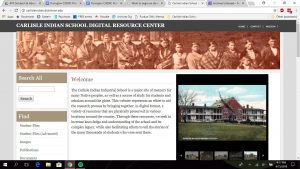by Katy Purington

The Carlisle Indian Industrial School in Carlisle, Pennsylvania was the first federally-funded Indian boarding school in the United States. Founded in 1879 by Captain Richard Henry Pratt, it became the model for 26 other federal boarding schools and hundreds of privately sponsored schools across the country. Between 1879 and 1918, more than 10,000 children from at least 140 tribes were brought to the school, most by force. Students learned English, trade skills, and Western customs. After the school closed in 1918, records related to the school became scattered across the country. The majority of the school’s official records are located in the US National Archives in Washington, DC, while other resources, including administrative ledgers, student photographs, and school newspapers, are held in private collections as well as the Cumberland County Historical Society and the Dickinson College Archives & Special Collections.
The Carlisle Indian School Digital Resource Center, started in 2013, was created to make it easier for families, communities, researchers, and educators to access records related to the Carlisle Indian School. It is led by College Archivist Jim Gerencser, Sociology Professor Susan Rose, and Special Collections Librarian Malinda Triller-Doran, and sustained by the efforts of many undergraduate interns and volunteers. According to the website’s mission page, the project “aims to develop a comprehensive searchable database of Carlisle Indian School resources.” The project’s stated goals include creating a searchable database using the information found in the digitized resources, developing a platform for the families and communities of former students to contribute records and images related to the school, and developing curriculum for teachers of all levels based on materials in the database. It is a massive project that is still a long way from being finished.
The largest collection of records available through the Resource Center are student files from the Records of the Bureau of Indian Affairs, housed at the National Archives in Washington DC. So far, over 6000 student files have been digitized, by student interns who travel to DC during school breaks. Other content includes images from a number of sources, publications produced by the Carlisle Indian School, and lists and ledgers containing information about school activities. Visitors to the website can also find information regarding the people buried in the cemetery of the Carlisle Indian School.
This past summer, Gerencser and Rose organized a one-week Teachers’ Institute on the Carlisle Indian School. The discussions among the teachers and Institute organizers resulted in the creation of a number of lesson plans and other resources for teaching the material, now available on the Resource Center website.
A team of project leaders has partnered with a number of Native communities that experienced the removal of large populations of children to the school. At events hosted in community centers, they demonstrate how to use the resources hosted on the website, as well as encouraging members of these communities to share their own stories about their family and friends who attended the school. In August 2017 , the Resource Center provided key resources in the Northern Arapaho nation’s successful bid to reclaim the remains of three boys who died while attending the School, and were buried in the cemetery. The students, whose identities were confirmed using school cemetery records and class rosters uploaded to the site, were disinterred and transported to Wyoming, where they were reburied by their families.
As more records are made accessible through the site, it will become easier for Native communities to track down students and find evidence of the lives they led during and after their years at the Carlisle Indian School. It will be important for the project leaders to continue their efforts in teaching members of the public, especially in communities impacted by the school, how to search for and use the available resources. The project has the potential to become a more powerful resource once it is better known.
